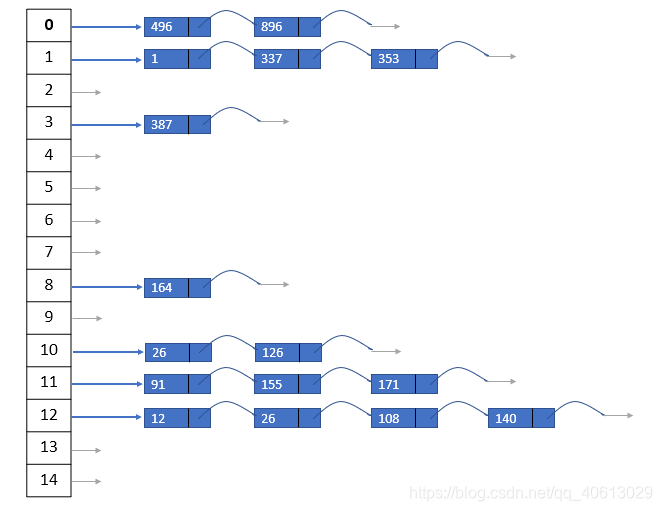哈希表
一、概述
散列表(Hash table,也叫哈希表),是根据关键码值(Key value)而直接进行访问的数据结构。它通过把关键码值映射到表中的一个位置来访问记录,以加快查找的速度。这个映射函数称为散列函数,存放记录的数组叫做散列表

二、举例分析
- 通过哈希表进行员工信息的管理
import java.util.Scanner;
/**
* @author DELL
* @Date 2020/2/4 17:57
**/
public class HashTableTest {
public static void main(String[] args) {
HashTable hashTable = new HashTable(10);
String key = "";
Scanner scanner = new Scanner(System.in);
while (true) {
System.out.println("add: 添加雇员");
System.out.println("dis: 显示雇员");
System.out.println("del: 删除雇员");
System.out.println("find: 查找雇员");
System.out.println("exit:退出");
key = scanner.next();
switch (key) {
case "add":
System.out.println("输入id");
int id = scanner.nextInt();
System.out.println("输入姓名");
String name = scanner.next();
Employee emp = new Employee(id, name);
hashTable.add(emp);
break;
case "dis":
hashTable.display();
break;
case "find":
System.out.println("请输入查找的id");
int i = scanner.nextInt();
hashTable.findEmployee(i);
break;
case "del":
System.out.println("请输入员工id:");
int n = scanner.nextInt();
hashTable.deleteEmployee(n);
break;
case "exit":
scanner.close();
System.exit(0);
break;
default:
break;
}
}
}
}
/**
* @author DELL
* @Date 2020/2/4 18:27
**/
public class HashTable {
EmployeeLinked[] employeeLinkedArray;
//链表的长度
private int size;
public HashTable(int size) {
this.size = size;
employeeLinkedArray = new EmployeeLinked[size];
for (int i = 0; i < size; i++) {
employeeLinkedArray[i] = new EmployeeLinked();
}
}
/**
* 添加员工
*
* @param emp
*/
public void add(Employee emp) {
int employeeLinkedIndex = hashFun(emp.id);
employeeLinkedArray[employeeLinkedIndex].add(emp);
}
/**
* 散列函数,使用取模法实现
*
* @param id
* @return
*/
public int hashFun(int id) {
return id % size;
}
/**
* 遍历哈希表
*/
public void display() {
for (int i = 0; i < size; i++) {
employeeLinkedArray[i].display(i + 1);
}
}
/**
* 根据id查找雇员
*
* @param id
*/
public void findEmployee(int id) {
int i = hashFun(id);
Employee employee = employeeLinkedArray[i].findEmployee(id);
if (employee == null) {
System.out.println("没有找到!");
} else {
System.out.println(employee.toString());
}
}
/**
* 根据id删除雇员
*
* @param id
*/
public void deleteEmployee(int id) {
int i = hashFun(id);
boolean delete = employeeLinkedArray[i].delete(id);
if (delete) {
System.out.println("删除成功!");
} else {
System.out.println("没有此员工!");
}
}
}
/**
* 存储雇员信息的链表
*
* @author DELL
* @Date 2020/2/4 18:30
**/
public class EmployeeLinked {
private Employee head;
/**
* 添加雇员,尾插
*
* @param emp
*/
public void add(Employee emp) {
if (this.head == null) {
head = emp;
return;
}
Employee cur = this.head;
while (cur.next != null) {
cur = cur.next;
}
cur.next = emp;
}
/**
* 打印所有信息
*
* @param no
*/
public void display(int no) {
if (this.head == null) {
System.out.println("第" + no + "条链表为空!");
return;
}
Employee cur = this.head;
System.out.println("第" + no + "条链表信息为:");
while (cur != null) {
System.out.println(cur.toString());
cur = cur.next;
}
}
/**
* 根据id查找雇员
*
* @param id
* @return
*/
public Employee findEmployee(int id) {
if (this.head == null) {
return null;
}
Employee cur = this.head;
while (cur.id != id) {
cur = cur.next;
}
return cur;
}
/**
* id的前一个节点
*
* @param id
* @return 找到返回true,否则返回false
*/
private Employee beforeID(int id) {
Employee cur = this.head;
while (cur.next.id != id) {
cur = cur.next;
}
return cur;
}
/**
* 根据id号删除雇员
*
* @param id
* @return 删除成功返回true,否则返回false
*/
public boolean delete(int id) {
if (this.head == null) {
return false;
}
if (this.head.id == id) {
this.head = this.head.next;
return true;
}
Employee beforeID = beforeID(id);
if (beforeID == null) {
return false;
} else {
beforeID.next = beforeID.next.next;
return true;
}
}
}
/**
* 雇员
*
* @author DELL
* @Date 2020/2/4 18:28
**/
public class Employee {
public int id;
public String name;
public Employee next;
public Employee(int id, String name) {
this.id = id;
this.name = name;
}
@Override
public String toString() {
return "Employee{" +
"id=" + id +
", name='" + name + '\'' +
'}';
}
}
